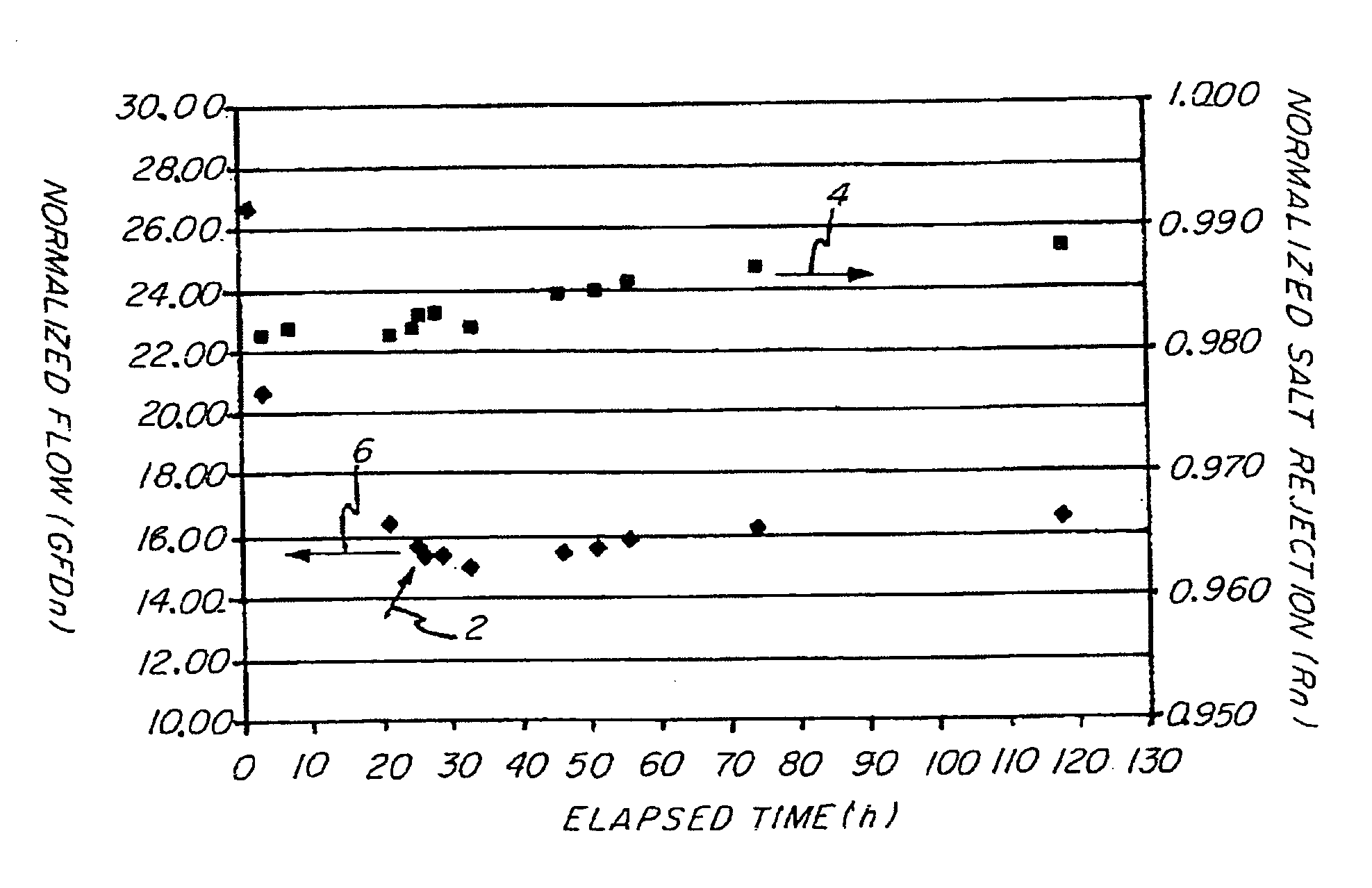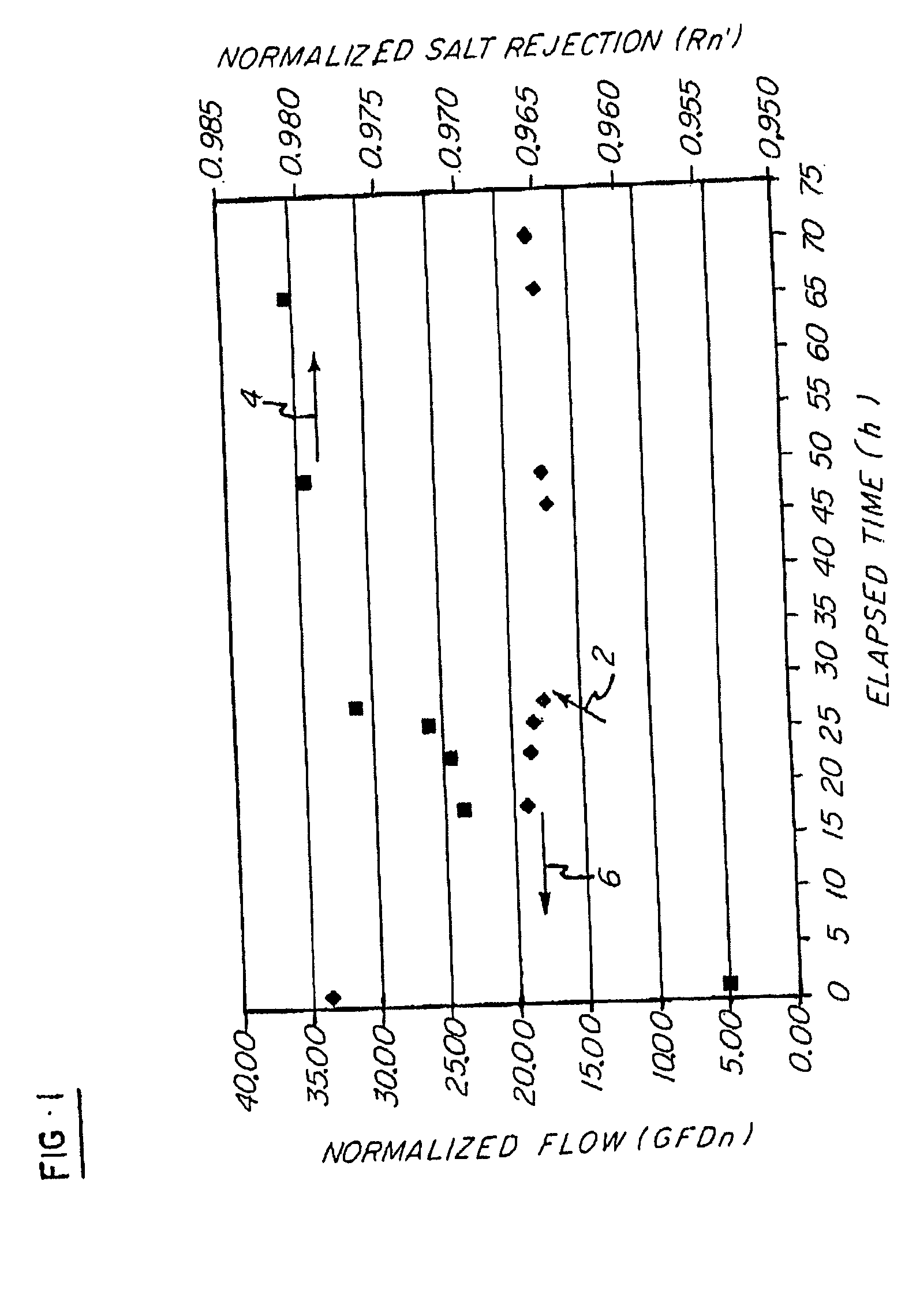Treatment of semi-permeable filtration membranes
a filtration membrane and semi-permeable technology, applied in the direction of reverse osmosis, filtration separation, separation processes, etc., can solve the problems of impede membrane flux and overall separation efficacy, and achieve the effect of increasing salt rejection rates, maintaining or improving flux, and inhibiting scale formation
- Summary
- Abstract
- Description
- Claims
- Application Information
AI Technical Summary
Benefits of technology
Problems solved by technology
Method used
Image
Examples
example 1
Polymerization of Acrylic Acid with Allyloxypolyethoxy(10) Sulfate (AA / APES)
This sample was prepared as described in Example 2 of Chen et al. U.S. Pat. No. 6,444,747 except a solution of sodium hypophsophite (2.5 mole % of the total monomer charge) was co-fed to the reactor during the first hour of the sodium persulfate feed. The product was then adjusted to pH ˜5 with 50% caustic, adjusted to ˜50% solids with DI water, and then isolated as an aqueous solution.
The structure of the resulting polymer was verified by 13C and 31P NMR. The viscosities of samples prepared by this method typically ranged from 150-300 cps.
example 2
Salt Rejection and Flow Studies
A standard recirculating cross flow testing unit was used to determine whether the treatments in accordance with the invention were effective in improving membrane performance of an R.O. polyamide membrane, specifically a TFC (Thin Film Composite) membrane Filmtec™ BW30. The treating unit included a 15 L holding tank that was provided upstream from the R.O. membrane separator unit. Both reject and permeate from the R.O. separator were recycled back to the holding tank.
System Operating Parameters were as follows. Transmembrane Pressure (TMP)=225 psig Feed Flow Rate=1.25 GPM Reject Flow Rate=1.0 GPM Temperature=25.0+ / −0.5° C. (controlled via a circulating chiller bath) pH=7.0+ / −0.5 Membrane=Filmtec™ BW30 (TFC polyamide, wet tested); 21.5 in2 Treatment: concentrated stock shot fed into system
Differences in normalized flow (NF) and normalized salt rejection (Rn) were determined upon addition of the treatment compared to no treatment. Throughpu...
example 3
In order to demonstrate efficacy of the invention in inhibiting scale formation in R.O. membrane systems, bottle tests were undertaken in an aqueous medium of the type prone to formation of calcium phosphate scale. In the bottle tests, synthetic waters were prepared with and without chemical treatment (e.g., no treatment and AA / APES), and varying levels of alkalinity, hardness, and phosphate. These waters simulate the concentrate from the last stage in a typical R.O. system. The waters were prepared so that calcium phosphate was the only possible scaling species. The bottles were agitated for one hour at 25° C., and then turbidities were measured and visual appearances were recorded. Water aliquots were then obtained and filtered through 0.2 μm filters and then analyzed via ICP-AE for PO4 levels. Differences in PO4 levels and turbidities between the non-treated and treated samples were used as the criteria for efficacy. The ideal case is to recover all ...
PUM
| Property | Measurement | Unit |
|---|---|---|
| water-soluble | aaaaa | aaaaa |
| mole ratio c | aaaaa | aaaaa |
| water soluble | aaaaa | aaaaa |
Abstract
Description
Claims
Application Information
 Login to View More
Login to View More - R&D
- Intellectual Property
- Life Sciences
- Materials
- Tech Scout
- Unparalleled Data Quality
- Higher Quality Content
- 60% Fewer Hallucinations
Browse by: Latest US Patents, China's latest patents, Technical Efficacy Thesaurus, Application Domain, Technology Topic, Popular Technical Reports.
© 2025 PatSnap. All rights reserved.Legal|Privacy policy|Modern Slavery Act Transparency Statement|Sitemap|About US| Contact US: help@patsnap.com



